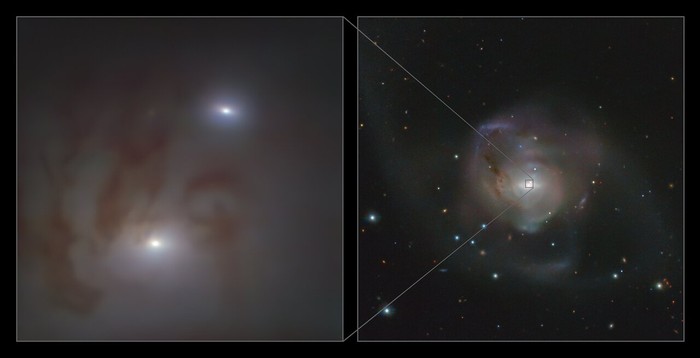A team of astronomers announces that they have discovered the pair of supermassive black holes closest to Earth known to date. They are also very close to each other, preparing for a possible upcoming merger.
The closest supermassive black hole to Earth is none other than Sagittarius A*, nestled in the center of the Milky Way just 26,000 light-years away. However, sometimes these cosmic monsters evolve in pairs. Until now, the closest known pair of supermassive black holes were over 470 million light-years away. More recently, astronomers have identified two such objects "only" 89 million light-years away . You will find them in the NGC 7727 galaxy.
Even more intriguing is the proximity between these two black holes, only 1,600 light-years apart . For comparison, it is less than half the distance that once separated the two previous record holders.
The larger of these two ogres is located right in the heart of the galaxy. It's almost 154 million times more massive than the Sun, while the latter is about 6.3 million times more massive than our star. And they are getting closer. "According to our analyses, these two objects should merge into a single black hole, probably within the next 250 million years “, says Holger Baumgardt, co-author of the study.

The presence of these two objects in the galaxy had long been suspected, but never confirmed. For this study, the researchers set out to measure their mass using the Multi-Unit Spectroscopic Explorer (MUSE), an instrument of the Very Large Telescope (VLT) in Chile. The latter allowed them to analyze the gravitational influence exerted by these two objects on the stars that surround them.
As you can see above, NGC 7727 is a very irregular galaxy with amorphous spiral arms, suggesting that it could be the result from a past galaxy merger . The presence of these two black holes approaching each other confirms this idea.
For authors, who publish their work in the journal Astronomy &Astrophysics, this new discovery suggests that there could be many more of these relics in the universe. Each of them could also contain many hidden massive black holes. To unearth them, researchers will soon be able to rely on ESO's European Giant Telescope (ELT), which is due to come into operation within the decade in Chile's Atacama Desert.